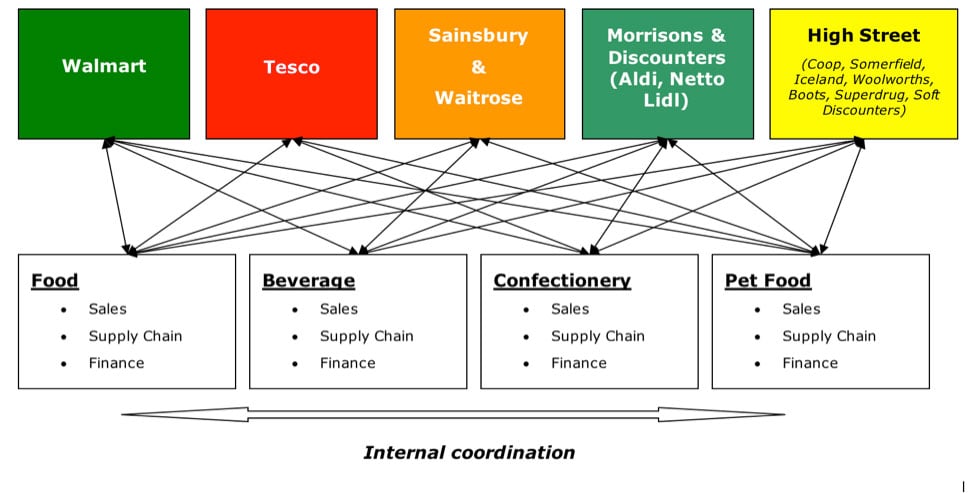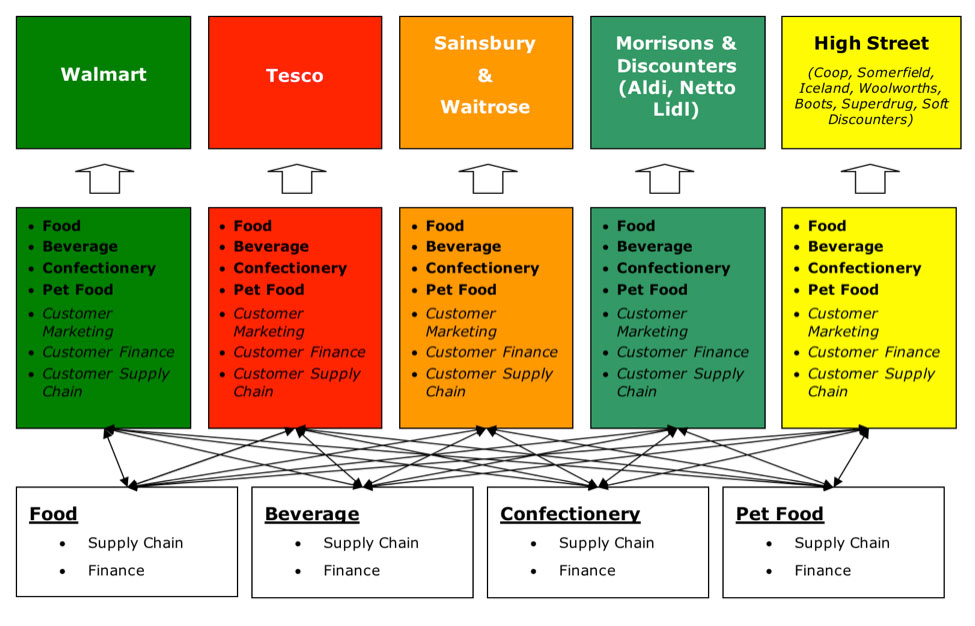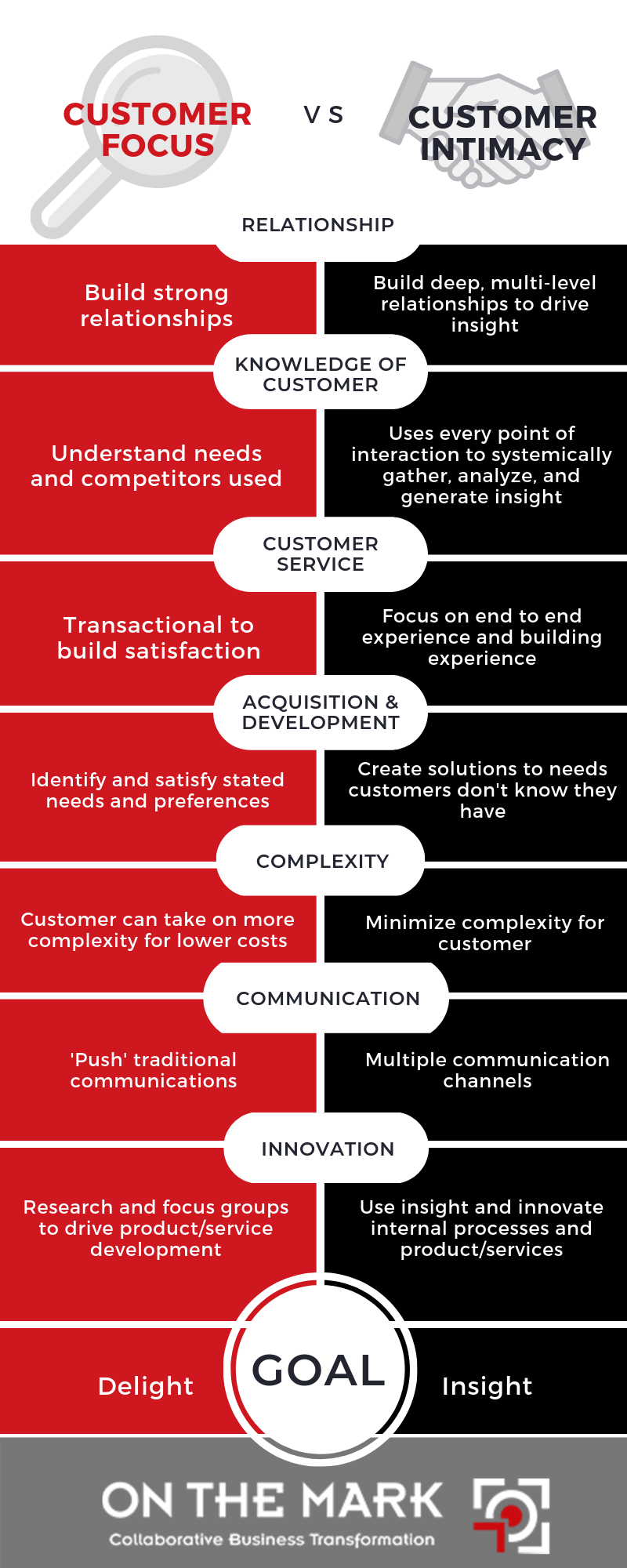Written by Simon Davies
In order to survive and grow, organizations must build a sustainable competitive advantage in the marketplace. Competitive advantage comes from creating an attractive value proposition that is different from other players.
What is Customer Intimacy?
“Customer Intimacy” is a strategy that creates a strong differential advantage and engaged consumers. However, it requires a fundamental re-alignment of the organization to deliver.
Research demonstrates that fully engaged customers deliver a 23% premium in terms of share of wallet, profitability, revenue and relationship growth. However, rationally ‘satisfied’ customers – those that indicate ‘satisfied’ or ‘fully satisfied’ on questionnaires – behave no differently than dissatisfied customers in terms of loyalty, profitability, and growth. (Manage Your Human Sigma, John H Fleming, Curt Coffman, and James K Harter; HBR July-Aug 2005)
To answer directly, customer intimacy is a strategy. A strategy that creates a competitive advantage that allows the organization to fully engage with its customers. It means segmenting and targeting markets, tailoring offerings, and predicting behaviors to match the demands of those niches. Truly customer intimate organizations know more about their customers than the customers know about themselves! Customer Intimacy is not an off-the-shelf product that organizations can merely implement at will. It is a major strategic decision that will often require a fundamental re-alignment of the organization to deliver it.
A common mistake when designing for customer intimacy is thinking it is the same as customer service. Customer service is a transactional, reactive process, essential for many organizations but it is not customer intimate. Let’s look at Apple, for example, their competitive advantage is ‘Product Leadership’, getting the best products to market, which arguably they do. They have the genius bar where you can book 1:1 appointments with a ‘genius’ who greets you by name and assists your needs. Good customer service but not customer intimacy. Nordstrom, on the other hand, has empowered its employees to do almost anything to ensure its customers get precisely what they want, customer intimacy.
Customer Focus vs Customer Intimacy
There is a significant and fundamental difference between becoming customer intimate, as a way of building a differential advantage, and having a customer focus; summarized below:
What does a Customer Intimate design look like?
Below is a customer intimacy example of a Fast-Moving Consumer Goods company (FMCG) which could be applied to any sales function and shows a move from a complex functional design to a more customer intimate design. The company had customers who bought products from four different parts of the organization, food, beverage, confectionery and pet food.
The customer would have separate points of contact for each of the four markets (see Figure 1 below for one of our customer intimacy examples). A complex process, involving duplication of work, variations in approaches and results, leading to wasted time for the customers. This coupled with poor internal coordination between each of the functional markets within the organization was increasing costs and reducing the company’s reputation with its customers.

Figure 1 – Market Functionalisation to Customer Design
To solve this problem the company went about moving all the complexity the customer was having to deal with in-house (see Figure 2 below for another one of our customer intimacy examples). They created customer teams which would do the work of talking to each market and then being a single point of contact for the customer. Keeping it simple, consistent and efficient.
The customer teams were able to work closely with their customer, building the relationship, tailoring solutions to their needs. On one level this approach increases some complexity in-house for the FMCG company. However this is outweighed by the overall benefits to the customer whose experience is improved. This improvement leads to better business performance and reputation for the FMCG in the wider market place. In turn they are better placed than their competitors to quickly respond to new products and services requirements.

Figure 2 – Customer Focused Hybrid Functionalisation to Customer Design
How do I design for Customer Intimacy?
At OTM we use an integrated and holistic methodology based around our Applied Star Model to take clients through a process of change. From business direction, value stream mapping and structure to management mechanisms, people process and reward. The process leaves no stone unturned when redesigning organisation to achieve their strategic goals. Working and supporting teams collaboratively from start to finish.
So how do organizations adopt customer intimacy?
Like any strategy, it is not one to be contemplated or pursued lightly. It requires trade-offs, focused leadership and an aligned organization to achieve it.
First the trade-offs:
The organization needs to select the market segments it wants to serve. A customer intimacy model requires higher levels of investment in understanding those customers, creating insight, and innovating solutions, so organizations need to be sure their targets have the means to pay for this.
Secondly, the value proposition needs to be established:
Not all customers are created equal and organisations must decide how they will segment their customer base and what they will offer to each segment.
Next, align the organization to deliver:
The whole organization must be configured to deliver the intended strategy. This is not just about putting good customer service at the ‘moments of truth’ where there are interactions (although this is important) but ensuring that the rest of the organization delivers on the promise.
The organization needs to be specifically designed in such a way that:
![]() Value creating processes simplify the customer experience as well as deliver consistent quality and experience – variation in experience is the enemy!
Value creating processes simplify the customer experience as well as deliver consistent quality and experience – variation in experience is the enemy!
![]() Power is placed in the organization to ensure customer needs and the customer’s voice is front and center. This is not the sole preserve of the traditional ‘customer’ functions of Marketing and Sales, but anywhere that interacts with or gains feedback from customers.
Power is placed in the organization to ensure customer needs and the customer’s voice is front and center. This is not the sole preserve of the traditional ‘customer’ functions of Marketing and Sales, but anywhere that interacts with or gains feedback from customers.
![]() Data and information about customers, their experience, and business environment is systematically gathered, analysed and synthesized into organizational responses.
Data and information about customers, their experience, and business environment is systematically gathered, analysed and synthesized into organizational responses.
![]() Solutions, processes and services can be innovated, tested and deployed rapidly.
Solutions, processes and services can be innovated, tested and deployed rapidly.
![]() Employees are highly engaged too – the wisdom being that highly engaged employees, create highly engaged customers.
Employees are highly engaged too – the wisdom being that highly engaged employees, create highly engaged customers.
Remember the Basics
While doing this, leaders must remember to get the basics right too. Good customer service and customer focus are not the difference but are ‘givens’ and must be executed well. Also important are efficient operations. It is too easy for costs to run away with higher and higher levels of service and customization. The answer is to be lean as possible – ruthlessly drive out things that are not to do with creating value or insight. Many successful organizations combine an intimate ‘front end’ with a very lean ‘back end’ operation so that the customer experiences the benefits of the customer intimacy strategy as well as the efficiencies of a lean operation.
Many organizations today are finding that their strategy has run its course. This is happening more and more in markets where multiple organizations have been following a product strategy and the where the market has become commoditized as the points of differentiation have become so small as to give no discernible value differential. In this environment, organizations then face the choice of competing on cost or following a customer intimate strategy.
Enjoy our blog? Sign up for our Free Monthly Digest.
Sign Up For Our Monthly DigestSimon Davies is a Senior Consultant at OTM. ON THE MARK’s experience and passion for collaborative business transformation that’s supported by pragmatism, systems thinking, and a belief in people is unparalleled. OTM is a global leader in organization design consulting.


